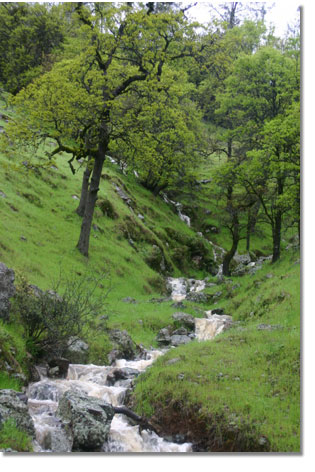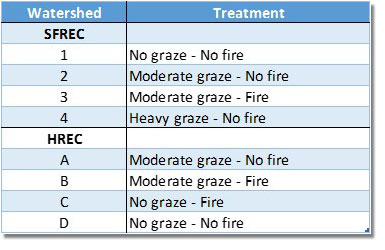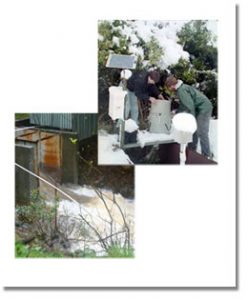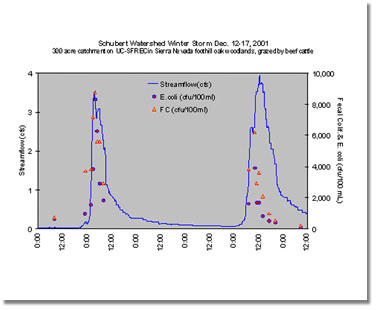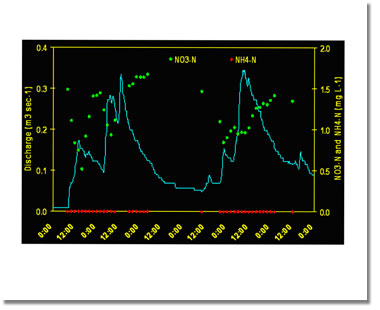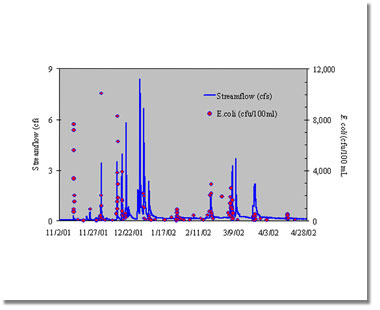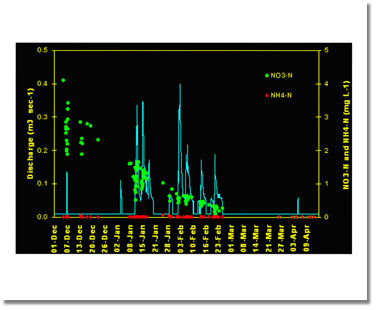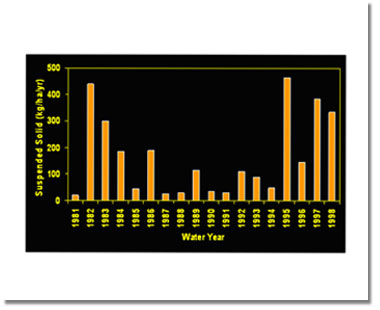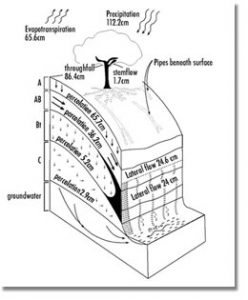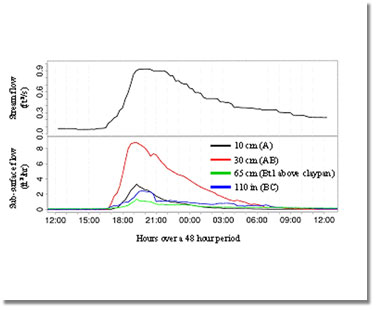Participants: Donna Dutra, Betsy Huang, Nikolai Schweitzer, Betsy Karle, Yukako Sado, Christian Carleton, Pete Sands, Randy Dahlgren, David Lewis, Mike Singer, Toby O’Geen, Barbara Allen-Diaz, SFREC, HREC
Introduction
There is a long history of research on oak woodland watersheds at the UC Sierra Foothill Research and Extension Center (SFREC), as well as the Hopland Research and Extension Center (HREC) in coastal Mendocino County, CA. Dr. Bob Burgy initiated studies at HREC in the late 1950’s and 60’s to examine watershed water and sediment yield response to conversion of vegetation from oak woodland to annual grassland. Results included an increase in storm runoff volumes and establishment of perennial summer streamflow conditions. There was also as much as 200 tons of sediment lost from the watershed due to a cascading series of landslides which occurred in the years following removal of trees and shrubs from the watershed (Dahlgren et al. 2001).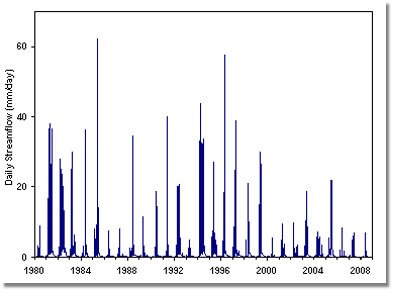
Dr. Mike Singer initiated studies at SFREC in the late 1970’s to begin the development of a long term record of weather, streamflow, and water quality. His efforts resulted in an on-going project which currently includes 30 years of data, providing a rare dataset for model development, climate change analysis, and examination of temporal variation inherent in natural processes such as streamflow, sediment yield, and nutrient flux. (Lewis et al. 2000, 2006)
Right: 30 year record of weather, streamflow, and water quality collected for the Schubert Watershed – UC SFREC.
Part 1: Watershed Study of Prescribed Grazing and Fire Management
In 1995, we instrumented three additional oak woodland watersheds at SFREC, four oak woodland watersheds at HREC, and three chaparral watersheds at HREC to examine various livestock grazing and prescribed fire treatments. Prescribed grazing and fire are the most cost effective vegetation management tools available to most rangeland managers. Prescribed grazing and fire can provide services such as invasive weed management, economic-agricultural sustainability, and fuel-wildfire risk reduction. However, the watershed-scale impacts of prescribed grazing and fire on water quality, hydrology, and nutrient cycling are the subject of intense debate on these rangelands.
Paired watershed studies are based upon:
1) all paired watersheds were managed under the same conditions for a pre-treatment period of several years
2) pre-treatment collection of streamflow, water quality, and weather data for all watersheds
3) application of a grazing/prescribed fire treatment to one or more watersheds, but the control watershed management remains the same as pre-treatment period
4) post-treatment collection of streamflow, water quality, and weather data for all watersheds for several years
5) statistical analysis to determine whether the relative differences between control and treatment watersheds change post-treatment
Over the past 10 years, we examined the affects of prescribed grazing and fire on eight oak woodland and three chaparral watershed streamflow and water quality.
All watersheds are equipped with flumes and automatic flow recorders to measure streamflow every 15 minutes. Each watershed has an automatic sample collection system allowing intensive collection of samples during storm events. Water samples are analyzed for sediment, nutrients, and microbial pollutant concentrations.
Preliminary Results:
As grazing intensity increased from no grazing to moderate (1000 lbs/acre RDM) to heavy (500 lbs/acre RDM) we found an increase in sediment, nitrate, and E. coli concentrations at SFREC. However, we found that dissolved organic carbon increased as grazing intensity decreased – due to an accumulation of biomass and subsequent decomposition and release of carbon. Regardless of grazing treatment, sediment and nitrate levels were low compared to water quality standards. E. coli concentrations exceeded EPA recommended standards regardless of grazing treatment, including no grazing. As seen in figure below, sediment, nitrate, and E. coli concentrations increased with grazing intensity.
We have consistently found that non-grazed oak woodland watersheds do not achieve the EPA recommended E. coli standard of 126 cfu/100mL. The figure below illustrates mean concentrations for two watersheds grazed moderately with sheep (A and B), and two watersheds not grazed by livestock since 1955 (C and D). We found no real change in stream water quality or volume due to the relatively low intensity of prescribed fires conducted on SFREC or HREC oak woodlands.
Part 2: Seasonal Water Quality Patterns
In addition to allowing us to test watershed management treatments, these data provide us with an improved understanding of when and how watersheds release various water quality constituents. This is critical to understanding the biogeochemistry of these watersheds, and for putting water quality monitoring results and regulatory efforts in context of natural watershed processes.
At the storm event scale – a matter of hours to a few days – we see distinct patterns in water quality throughout a storm. For instance, we find that E. coli concentrations can increase by 2 to 3 orders of magnitude within a matter of hours on the rising limb of the storm hydrograph, only to drop another 2 to 3 orders a few hours latter. Alternatively, we find that nitrate concentrations can actually drop during a storm event due to dilution.
At the seasonal scale – December through April – we see a distinct flushing of nitrate and microbial pollutants with the first few runoff events of the year. There is a slow build up of nitrate in the upper soil horizons during the summer drought period when plant nutrient demand is low. There is also a build up of nitrate during this period due to atmospheric deposition from up-wind agricultural and urban pollution sources. The first rains of the season flush accumulated N from the system as runoff.
Part 3: Streamflow Generation Processes
Streamflow generation processes determine the hydrologic pathways by which pollutants on rangelands are transported to streams. We have examined how annual rangeland watersheds produce streamflow during storms by developing and monitoring sub-surface runoff plots. Plots are designed to collect lateral sub-surface flow from four different soil depths located at major soil horizon boundaries (10, 30, 65, and 110 cm), allowing measurement of flow rates from each soil horizon.
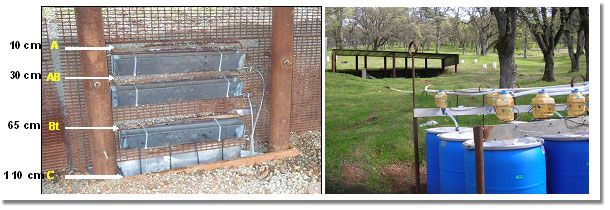 We have found that the dominant hydrologic flow-paths in soils typical of annual rangelands in the Sierra Nevada is lateral, sub-surface flow through the upper soil layers (A and AB horizons) within 65 cm of the land surface. The A and AB horizons have high permeability and prevalent macropores. During the course of a single rainfall-runoff event in the winter of 2007, we found that peak stream flow was sustained for approximately 3 hours and corresponded with the initiation of lateral flow through the AB soil horizon located above the claypan (Bt horizon at 30 to 65 cm). Over 90% of the stream flow generated by this storm was transported to the stream channel as shallow sub-surface flow.
We have found that the dominant hydrologic flow-paths in soils typical of annual rangelands in the Sierra Nevada is lateral, sub-surface flow through the upper soil layers (A and AB horizons) within 65 cm of the land surface. The A and AB horizons have high permeability and prevalent macropores. During the course of a single rainfall-runoff event in the winter of 2007, we found that peak stream flow was sustained for approximately 3 hours and corresponded with the initiation of lateral flow through the AB soil horizon located above the claypan (Bt horizon at 30 to 65 cm). Over 90% of the stream flow generated by this storm was transported to the stream channel as shallow sub-surface flow.
Additional Information
- Chow, A.T., T.L. Seong, A.O.Geen, T. Orozco, D. Beaudette, K.W. Po, P.J. Hernes, K.W. Tate, and R. Dahlgren. Litter Contributions to Dissolved Organic Matter and Disinfection Byproduct Precursors in California Oak Woodland Watersheds. J. Environmental Quality.
- Dahlgren, R.A., K.W. Tate, D.J. Lewis, E.R. Atwill, J.M. Harper, and B.H. Allen-Diaz. 2001. Watershed Research Examines Rangeland Management Effects on Water Quality. CaliforniaAgriculture. 55:64-71.
- Lewis, D.J., M.J. Singer, R.A. Dahlgren, and K.W. Tate. 2000. Hydrology in a California Oak Woodland Watershed: a 17-Year Study. J. Hydrology. 230:106-117.
- Lewis, D.J., M.J. Singer, and K.W. Tate. 2000. Applicability of SCS Curve Number Method for a California Oak Woodland Watershed. J. Soil and Water Conservation. 55:226-230.
- Lewis, D.J., M.J. Singer, R.A. Dahlgren, and K.W. Tate. 2006. Nitrate and Sediment Fluxes from a California Rangeland Watershed. J. Environmental Quality. 35:2202-2211.
- O'Geen, A.T., R A. Dahlgren, A. Swarowsky, K.W. Tate, D.J. Lewis, and M.J. Singer. 2010. Connecting Soil Hydrology and Stream Water Chemistry in California Oak Woodlands. California Agriculture.
- Tate, K.W., R.A. Dahlgren, M.J. Singer, B. Allen-Diaz, and E.R. Atwill. 1999. On California Rangeland Watersheds: Timing, Frequency of Sampling Affect Accuracy of Water Quality Monitoring. California Agriculture. 53:44-48.

